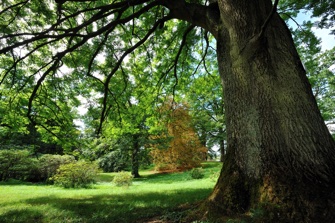
Right beside Marie-Antoinette’s make-believe farm on the grounds of the Château de Versailles is a kind of secret garden, open to the public but practically unknown to it. This is no ordinary garden, however, but a tree garden, a kind of open-air tree museum, the Arboretum de Chèvreloup.
For a tree lover like me, Chèvreloup is paradise. On its 200 hectares (50 of them open to the public) grow 2,500 species and varieties of trees from every continent. While this unusual forest provides a welcome fresh-air retreat for pollution-beleaguered Parisians, its true raison d’être is scientific. It is used for research and educational purposes, and serves as a reservoir of biodiversity. Landscape architects also visit for inspiration and information.

Even the trees use it, in a sense, as a kind of safe haven. Cedars in the Paris region, for example, are being attacked by a fungus that their relatives at Chèvreloup have so far been spared, thus preserving specimens of the tree. This is a bad time for trees in France; other beloved species, like ash, chestnut and the plane trees that so beautifully line the country roads, are also in danger from various maladies, making the arboretum’s role even more vital.

Among the arboretum’s woody treasures, in addition to the oaks, maples, limes, firs, pines and spruces, are one of the world’s largest collections of magnolias, an 80-year-old Chinese cork oak and a beautiful stand of chestnuts with red and white flowers on a low ridge (because the chestnut cultivar with red flowers was developed in Versailles, legend has it that they were tinted by the blood of those guillotined during the French Revolution).

The arboretum is also home to a number of greenhouses sheltering some 8,000 tropical plants, some of them rare and endangered, and notable collections of fuchsias and orchids. The domain’s greenhouses also serve as suppliers of flowers to the the Jardin des Plantes in Paris. When I was there in May, 2,000 sunflowers were being cultivated for the Paris garden.
Normally closed to the public, the greenhouses are occasionally open for guided tours. Check the website for details.

This former farm next to the Petit Trianon was acquired by Louis XIV In 1699 and served as a botanical garden for a time. In 1927, it was attached to the Muséum National d’Histoire Naturelle in Paris, with which it is still affiliated. During World War II, starving locals were allowed to grow vegetables on the domain. It wasn’t until 1967 that work really began on creating the current arboretum, which suffered a major setback in 1999, when a violent storm knocked down some 1,800 trees, including a sophora planted in 1747, which began to grow again from its stump in 2002.
Visitors can follow a marked trail to see 40 of the most remarkable trees in the arboretum.
Arboretum de Chèvreloup: 30, route de Versailles, 78150 Rocquencourt. Bus B or H from one of the three train stations in Versailles to the stop Centre Commercial Parly II. Tel.: 01 39 55 53 80. Open 10am-6pm (until 5pm November 1-February 28). Closed May 1 and Dec. 25-Jan. 1. Admission: €6. www.arboretumdeversailleschevreloup.fr
Favorite
